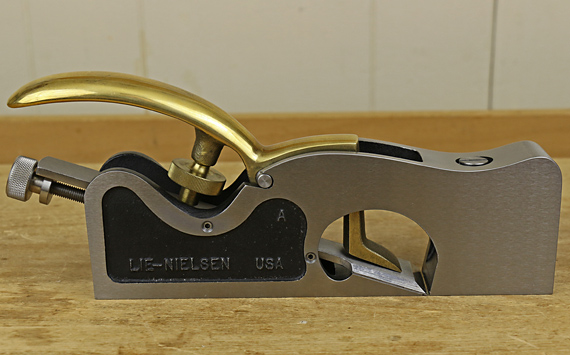
In considering features of all-metal shoulder planes, I will say at the outset that I am not entirely happy with any that I have owned or tried out. Later, I will explain a partial remedy.
Let’s look at some of the key features of planes from the two major players, Veritas and Lie-Nielsen. Spoiler alert: there’s a deal killer coming.
1- The blade adjustment knob of the Veritas controls both the depth and angle of the cutting edge. This is handier than the single function depth adjuster on the L-N.
2- Both planes have an excellent adjustable mouth but, like many vintage infill shoulder planes, the Veritas’ is set significantly further back from the front of the plane than is the Lie-Nielsen mouth. I find the longer initial registration of the sole on the work makes it easier to work accurately.
3- The Veritas has a special hole in the body and knobs that some woodworkers may find helpful in gripping the plane. I tend to like fewer of such grip aids on tools, and find that the L-N handles just as well as the Veritas.
4- The Veritas plane uniquely has four set screws in the body that make it easier to set and maintain the blade alignment. Shoulder planes are finicky to adjust; the screws really help.
5- Both planes are made from stress-relieved ductile iron to the wonderfully precise standards that woodworkers gratefully expect from these two great companies. We can count on receiving a plane with a good 90° angle between the sole and both sides. The blades come well prepared and are of excellent steel. As for the small matter of looks, I do not really care, but if there was a shoulder plane beauty contest, let’s just say that the Veritas has a shot at Most Congenial.
Why, then, do I own a L-N and not a Veritas shoulder plane? Because Veritas has, for me, a real Deal Killer.
The Veritas blade is bedded at 15°. This scant support makes the sole too sensitive to downward deflection beneath the blade. Working with the medium size Veritas, I found that the deflection is quite variable with even small changes of torque on the lever cap wheel. Lee Valley instructs that while little clamping pressure is required, the deflection itself can be used to tune the cutting depth. My interpretation of this is that the lever cap pressure is assigned two purposes, which may be at odds with each other.
Sure, any plane sole that lacks side support, such as on a shoulder plane, can be made to deflect with enough pressure from the lever cap, but for my money, the Veritas shoulder plane was just too sensitive to this. Though the set screws do indeed help maintain the blade alignment, I found that making the blade reasonably secure involves creating an annoying bump in the sole.
This bump prevents the plane sole from registering on the work as well as it otherwise might; it rocks. If it is important for the sole of a plane used for precision work to be very flat, say within a thou or so, what sense is there in tolerating a noticeable bump behind the blade?
The 18° bed of the L-N resists deflection much better. This is why, all things considered, I prefer the Lie-Nielsen shoulder plane. Perhaps there are factors in the design of their plane body other than the bed angle that also contribute to this better resistance to deflection. Taking the matter further, maybe a 20° or 22° bed would even better resist deflection, as those are very workable bed angles in general for a bevel-up plane.
Next: an easy modification (yes, you can see it above)


Long time reader, first time commenter :)
For what it’s worth, David Charlesworth recommends setting a shoulder plane to appropriate compression/deflection, but with the blade withdrawn, and then lapping it for a few strokes on a fine abrasive. That way the deflected metal is removed and it will be flat when under compression/deflection. I tried this and it wasn’t much removal at all, but it was at least a shaving’s thickness — so something that definitely is worth doing.
Hope this is an interesting idea!
Thanks, Jamie. I am aware of David’s fix. I was anticipating a comment or two along those lines, and probably should have addressed the matter more specifically in my post.
There are two problems, as I see the matter.
First, I don’t think one should have to fix up a new, expensive tool like that.
Second, once flattened, variability remains an issue. One must reproduce the wheel tension that was in place during the flattening operation. Now, if the bed is reasonably stiff, then there would be a sufficient range of wheel tension that would retain the flatness without being unduly sensitive.
But Lee Valley is, in effect, acknowledging that the bed deflection is VERY sensitive to wheel tension: they suggest using the wheel tension as an auxiliary method to adjust the cutting depth! With all due respect to the wonderful folks at Lee Valley, I think that is a poor way to design a plane.
Why not just make the bed stiffer and much less sensitive to wheel tension? Then if the sole of a new plane needs a bit of attention, flatten it as David recommends, but knowing that then the sole will maintain its flatness through a reasonable range of wheel tension.
In short, the Veritas plane sole is simply TOO sensitive to deflection by pressure from the lever cap. It is a matter of degree.
And there is, to my mind, no advantage gained by the more flexible 15° bed.
I think they should redesign the bed of an otherwise excellent tool. Some time ago, I had an amicable conversation about the whole matter with a major person at Lee Valley but the person did not agree with me. (I say “person” to keep a private conversation private.)
Rob